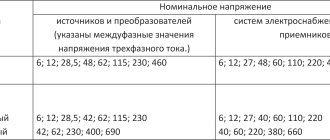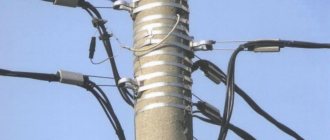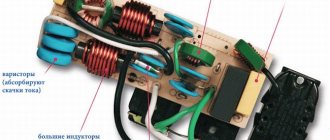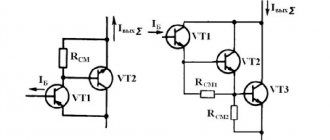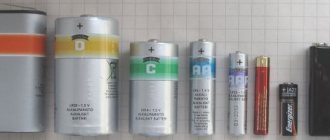Nuances and examples in questions and answers
Newbies often have a question:
“If you turn off the input circuit breaker, switch or other switching device in an electrical installation, will it be considered operational?”
The answer is Yes! As mentioned above, an electrical installation is considered to be operational if voltage can be supplied by switching devices. That is, if they are disabled, this does not mean that they cannot be enabled by anyone. In order for the power plant to become inoperative, it is necessary not only to turn off the disconnectors, but also to disconnect or ground the power cable, and also issue an order that the power plant is transferred to “Inactive”.
Another equally important question:
“What is an electrical installation in practice?”
In simple terms, your house or apartment is an electrical installation, it includes a cable line from a support (if the input is organized by air), an incoming electrical panel, a metering panel and all devices that are consumers of electricity. Its boundaries are determined by the agreement and the balance sheet ownership of the overhead line sections. Thus, within one premises there can be several power plants that are on the balance sheet of different companies; moreover, even one power line in its different sections is serviced by specialists from different organizations.
We looked at the definition of the concept “Operating electrical installation” and what applies to it. It is worth noting that the interpretation of the concept, although unambiguous, is enshrined in only two documents, and it is in PTEEP that the term is given more precisely and extensively.
Do not miss:
- Online test on electrical safety, group 3
- Online knowledge test for electricians
- Malfunctions in electrical installations and the causes of their occurrence
Published: 12/06/2018 Updated: 12/06/2018
Initial admission, preparation
The specified measures can be carried out only after its authorization by operational employees in charge of the electrical installation or a person appointed by the management of the facility.
Restrictions:
- it is prohibited to give out before the arrival of the performers;
- Admission is possible according to 1 order, order.
The provisions of the training order cannot be changed. If the manufacturer allows one person, then one of the performers with III gr. is involved in the event.
The admitter verifies the preparation by inspecting the object, checking with logs, operational data, messages, and then grants admission. Next, the manager and the supervisor find out from him what has been done, then they do a joint inspection by inspection. If there are no operational employees (but with their permission), the check can be performed by two specified persons.
Admission is made directly on site after checking the preparation. When the latter is not required and the work is carried out by order, the specified event is not mandatory, and it is not done on overhead lines, overhead lines, cable lines. Registration consists of marks and signatures on the orders. A record is made in 2 copies. of this document: for the observer and the admitter, and if this is one person (combining responsibilities), then in 1 copy. A mark is placed in the accounting books and operational data.
Preliminary actions of the person admitting:
- checks the identity of (groups of) performers;
- proves that there is no voltage: shows grounding or checks in another way. In power plants up to 35 kV, it is verified by touching, if possible, current-carrying elements.
1.7.10
Materials from the investigation of accidents associated with the operation of electrical installations, as well as violations of labor safety requirements, must be carefully analyzed to identify the cause and culprit of their occurrence, and to take measures to prevent such cases.
Accidents must be reported, investigated and recorded in accordance with the established procedure.
Responsibility for the correct and timely investigation and recording of accidents, execution of Form N-1 acts, development and implementation of measures to eliminate the causes of the accident lies with the head of the Consumer.
Purpose ↑
It is difficult to imagine modern life without electrical installations. This applies to everyday life, work, and recreation. It is these devices that are responsible for generating, transforming and redistributing electric current, which is now one of the main energies.
They are simply necessary to ensure the operation of enterprises. Very often the central network is not enough to obtain the necessary power; a huge amount of equipment requires a special approach. Also, many facilities must have a backup power system: for example, in hospitals, even a temporary loss of voltage due to any emergency can lead to death.
Electrical installations are often used to generate electricity using solar, water, air or nuclear energy.
1.5.36
When switching in electrical installations, the following order must be observed:
the employee who received the switching task is obliged to repeat it, write it down in
operational journal and establish the order according to the operational scheme or layout diagram
upcoming operations; draw up, if necessary, a switching form. Negotiation
operating personnel must be extremely concise and clear. Operative language
must exclude the possibility of staff misunderstanding received messages and transmitted orders. The giver and receiver of the order must clearly understand the order of operations;
if switching is performed by two workers, then the one who received the order is obliged to explain, using the operational connection diagram, to the second worker participating in the switching, the order and sequence of upcoming operations;
if there are any doubts about the correctness of the switching, they should be stopped and the required sequence should be checked according to the operational connection diagram;
After completing the switching task, an entry about this should be made in the operational log.
Breaks, re-admissions
Actions during pauses caused by lunch, the nature of the actions performed:
- the performers are removed, the control room is locked with a padlock;
- workers are prohibited from returning without the manufacturer, who keeps the work order, and he also allows them after such a pause, and no mark is needed.
During breaks due to the end of the day:
- the object is completely freed from performers;
- auxiliary, protective structures (signs, etc.) are left;
- the manufacturer hands over the work order to the admitting person or leaves it in a special place (in a folder). In an EU without operational staff, you can keep the paper at home.
The finish of the work is recorded by the manufacturer in his copy of the work order. Admission on subsequent days is carried out by the admitter or, if authorized, by the manager without permission from a superior employee from the operational staff. If there is the consent of the person admitting, then the team can be admitted if there is an order, but this must be accompanied by an entry in the “Separate instructions” column.
When starting actions the next day, the manufacturer verifies the integrity of the safety structures left behind (signs, grounding), allows and registers this in the work order. If the last action is carried out by an admitter from the operational staff, then records are made in 2 copies.
1.7.17
When carrying out construction, installation, adjustment and repair work on existing electrical installations of the Consumer, third-party organizations must develop joint measures for labor safety, industrial sanitation, explosion and fire safety, taking into account the interaction of construction, installation and operating personnel. The heads of organizations carrying out this work are responsible for the qualifications of their personnel, their compliance with safety requirements and for organizing and implementing occupational safety measures at their work sites.
When performing work on the same equipment or structure simultaneously by several organizations, a work organization plan must be drawn up.
Precautions when using electrical installations
When it comes to existing electrical installations, you definitely need to think about safety. There are several factors to consider. Follow the rules carefully so that no emergencies arise in the future.
First of all, it is necessary to carefully carry out the installation, pay due attention to grounding, and also try to work out the insulation. It is necessary to carry out regular electrical measurements of electrical installations, as well as general tests of electrical installations. Their main task is to analyze the system (so that there are no violations anywhere). It is also important to conduct emergency training. Evacuation plans in the event of a fire, for example, should be posted in a visible place.
If you devote enough time and effort to these moments, then in the future the likelihood of unpleasant consequences will be minimized.
1.4.4
Non-electrical personnel performing work that may pose a risk of electric shock are assigned electrical safety group I. The list of positions and professions requiring assignment to personnel of electrical safety group I is determined by the head of the Consumer. Personnel who have mastered the electrical safety requirements related to their production activities are assigned group I with registration in a journal of the established form; no certificate is issued.
Assignment to group I is made through instruction, which, as a rule, should be completed with a knowledge test in the form of an oral survey and (if necessary) a test of acquired skills in safe working methods or providing first aid in case of electric shock. The assignment of electrical safety group I is carried out by an employee from among the electrical technical personnel of a given Consumer with an electrical safety group of at least III.
Assignment of electrical safety group I is carried out at least once a year.
Work permit
The work permit is a task and a tool for authorization, the basis for ensuring electronic security. You will need 2 copies, and when transferring remotely - 3 copies. and at the same time, the issuer fills out 1 copy, and the receiver fills out 2 copies. and writes his full name in place of the signature of the first, certifying the data with his signature. The quantity of the specified organizational instrument for one responsible person is determined by the issuer. You can issue several of them (as well as orders) for sequential execution.
For the document in question there is a special form that defines:
- for work: possible actions, goals, time, safety conditions;
- performers, responsible persons.
Validity and storage periods for outfits:
- up to 15 cal. days from the start date of work;
- extended no more than 1 time per 15 cal. days;
- remains relevant during breaks;
- another employee with the right to issue a document for the used EC has the right to renew;
- store for 30 days. after execution, then destroyed.
Rules for Technical Operation of Consumer Electrical Installations (PTEEP), edition 2003.
| < Chapter 3.2 Electrothermal installations, Electrode boilers |
| Section 3 Electrical installations for special purposes |
| <> Contents <> |
| Section 3 Electrical installations for special purposes |
| > Chapter 3.4 Electrical installations in hazardous areas > |
Section 3
Electrical installations for special purposes
Chapter 3.3
TECHNOLOGICAL POWER PLANTS OF CONSUMERS
3.3.1. This chapter applies to stationary and mobile sources of electrical energy (gasoline, diesel, gas), with an installed capacity of up to 30,000 kW with units with a unit capacity of up to 10,000 kW (hereinafter referred to as consumer technological power plants - TEP), used as main, peak, backup and emergency power supplies for consumer electrical receivers.
3.3.2. The design, design and insulation class of electrical machines, devices, devices and other equipment on TEP, as well as wires and cables, must correspond to the parameters of the network and power receiver, environmental conditions and external influencing factors, or protection against these influences must be provided. The equipment, devices and other devices used at the TEP must comply with the requirements of state standards or technical specifications approved in the prescribed manner.
3.3.3. TECs are allowed for operation on which equipment, protection and automation devices, instrumentation and alarm systems, wires and cables, and protective equipment are fully installed, checked and tested to the required extent.
3.3.4. When accepting TEP into operation, the operating mode of the neutral of the power plant and protective electrical safety measures must correspond to the operating mode of the neutral and the protective measures taken in the network (power receivers) of the Consumers.
3.3.5. Manual connection of an emergency or backup TES to the Consumer's networks (power receivers) is permitted only if there are interlocks between the switching devices, which preclude the possibility of simultaneous supply of voltage to the Consumer's network and to the network of the energy supplying organization.
3.3.6. Automatic switching on of an emergency or backup TES in the event of a loss of voltage from the power system must be carried out using automatic devices that ensure the preliminary disconnection of the switching devices of the Consumer's electrical installations from the network of the energy supplying organization and the subsequent supply of voltage to the electrical receivers from the power plant.
3.3.7. Before commissioning of a thermal power plant, the operation of which is possible in parallel with the network of the energy supplying organization, an instruction defining the operating mode of the thermal power supply must be developed and agreed upon with the energy supplying organization.
3.3.8. In the case of installation of an automated system for commercial metering of electricity (hereinafter referred to as AMR) at the border of the TEP's balance sheet, switching on and off the TEP in the main and peak modes is carried out with notification of the operational personnel of the energy supplying organization (power grids).
3.3.9. To service the TEP, trained personnel with the appropriate qualification group in electrical safety must be allocated. Operating personnel in their actions must be guided by the requirements of the instructions for the maintenance and operation of TEC in accordance with regulatory documents.
3.3.10. For each type of maintenance and repair of TEC, deadlines must be determined taking into account the manufacturer’s documentation. Inspection of a station located in reserve must be carried out at least once every 3 months.
3.3.11. The readiness for start-up of the TEP, the duration of its operation at idle or under load, as well as the results of inspections and checks of the operation of the station must be documented in the operational documentation.
3.3.12. Information about the availability of backup stationary or mobile thermal power plants, their installed power and rated voltage value are indicated in the energy supply contract and are reflected on electrical diagrams.
3.3.13. Preventive testing and measurements of parameters of electrical equipment (except generators), grounding devices, apparatus, wires, cables, etc. must be carried out in accordance with electrical equipment testing standards (Appendix 3).
| < Chapter 3.2 Electrothermal installations, Electrode boilers |
| Section 3 Electrical installations for special purposes |
| <> Contents <> |
| Section 3 Electrical installations for special purposes |
| > Chapter 3.4 Electrical installations in hazardous areas > |
Electrical equipment classes
Electrical equipment has always been divided into classes, the main of which are ways to protect people from electric shock:
- Class zero deals only with minimal insulation. It provides air gaps.
- The first class is connected to the electricity network with three-core cables. It acts as a means of communication with the protective conductor.
- The second class provides protection and enhances insulation through grounding. This doubles your overall protection.
- The third class deals with electrical power from low voltage and its various sources.
For a safe and productive process of interaction with devices, circuits, devices and reasonable energy consumption, basic knowledge will certainly help and rescue in case of problems and malfunctions.
1.4.12
The head of the Consumer or structural unit may exempt from internship an employee with at least 3 years of experience in his specialty who moves from one workshop to another, if the nature of his work and the type of equipment on which he worked previously does not change.
Admission to the internship is issued by the relevant document of the head of the Consumer or structural unit. The document indicates the calendar dates of the internship and the names of the employees responsible for its implementation.
The duration of the internship is set individually depending on the level of professional education, work experience, and profession (position) of the student.
Sample work permit for work in electrical installations
What height of a bathtub from the floor is considered standard?
State legislation in the field of labor protection does not establish a strict framework for the production and approval of a standard form for such an access order. Accordingly, enterprises themselves can develop a special form that will take into account the rules for maintaining their own document flow, as well as the specifics of its activities. However, the document must comply with legal requirements and must contain:
- The name of the organization and the obligatory stamp in place of the date of publication of the relevant document;
- Order of the enterprise, its number and date, on the basis of which the standard document was developed;
- Signature of the manager or responsible specialist responsible for issuing the act;
- Initials and positions of employees involved in the work;
- The start and end time of current work with the obligatory indication of the hourly interval, as well as the telephone number of the responsible services;
- Initials of the head of the staff unit monitoring ongoing preventive, repair or other measures;
- Mandatory indication of the type of work and its nature, indicating the name of the equipment and its voltage;
- Indication of targeted training on knowledge of technical standards and safety rules when working with electric current;
- Signatures of employees who were instructed and who will carry out direct work activities.
Note! Organizations can also independently enter additional information about the object of work, the specifics of such actions, as well as the use of special protective equipment if necessary.
An example of a fully completed permit for work in live installations
As a result, the permit for work in electrical installations is a mandatory internal document that authorizes a certain circle of employees to carry out such work. In its absence, officials in the event of an abnormal or emergency situation are subject to varying levels of responsibility from regulatory government agencies.
1.5.1
The Electrical Energy Consumer's electrical management system is an integral part of the energy management system, integrated into the Consumer's management system as a whole, and must provide:
operational development of the Consumer's power supply scheme to meet his electricity needs;
efficient operation of electrical facilities by improving energy production and implementing energy saving measures;
increasing the reliability, safety and trouble-free operation of equipment; renewal of fixed production assets through technical re-equipment and reconstruction of electrical equipment, modernization of equipment;
introduction and mastery of new equipment, operation and repair technology, effective and safe methods of organizing production and labor;
advanced training of personnel, dissemination of advanced labor methods and economic knowledge, development of rationalization and invention;
operational dispatch control of electrical facilities, including its own sources of electrical energy, agreed with the energy supply organization;
control over the technical condition of one’s own electrical installations and the operation of one’s own sources of electrical energy operating autonomously (not being block stations);
control over the organization’s compliance with the operating modes and energy consumption limits assigned to it by the energy supply organization.
Electrical safety classification
The rules in paragraph 1.1.32 fix how all electrical installations are divided according to electrical safety conditions:
- EI with voltage up to 1000 V (1 kV);
- EI with a voltage of more than 1000 V (1 kV).
The criterion for separating settings is the voltage value. Examples of devices with voltages above 1000 V:
- high-voltage power lines;
- transformer substations;
- powerful electric motors.
Most consumers use equipment designed for voltages less than 1000 V. Industrial enterprises usually consume energy with a voltage of 380 V to supply power to units (machine tools, pumps, complex mechanisms). In domestic systems, 220 V is usually used.
Appliances
For your information! Often, a cable with a voltage of more than 1 kV is supplied to the object, then a decrease to the required value occurs in the transformer substation. Moreover, it can be a separate building or located inside the room where the electricity receivers are located.
For example, a boiler room uses equipment powered from a 380 V network. In the same building there is a substation with transformers that lower the voltage from 6 kV to 0.4 kV. The requirements for its maintenance are higher, since it already belongs to a class of more than 1 kV .
Rules for Technical Operation of Consumer Electrical Installations (PTEEP), edition 2003.
| < Chapter 1.2 Responsibilities, consumer responsibility for compliance with the rules |
| Section 1 Organization of operation of electrical installations |
| <> Contents <> |
| Section 1 Organization of operation of electrical installations |
| > Chapter 1.4 Personnel requirements and training > |
Section 1
Organization of operation of electrical installations
Chapter 1.3
ACCEPTANCE FOR OPERATION OF ELECTRICAL INSTALLATIONS
1.3.1. New or reconstructed electrical installations and start-up complexes must be put into operation in the manner set out in these Rules and other regulatory documents.
1.3.2. Before installation or reconstruction of electrical installations, it is necessary to:
obtain technical specifications from the energy supply organization;
complete design documentation;
coordinate the design documentation with the energy supply organization that issued the technical specifications and the state energy supervision body.
1.3.3. Before accepting electrical installations into operation, the following must be carried out:
during the construction and installation of a power facility - intermediate acceptance of equipment units and structures, including hidden work;
acceptance testing of equipment and commissioning tests of individual electrical installation systems;
comprehensive testing of equipment.
1.3.4. Acceptance tests of equipment and commissioning tests of individual systems must be carried out according to design schemes by the contractor (general contractor) with the involvement of the customer’s personnel after completion of all construction and installation work on the electrical installation being delivered, and comprehensive testing must be carried out by the customer.
1.3.5. Before acceptance and commissioning tests and comprehensive testing of equipment, compliance with these Rules, rules for electrical installations, building codes and regulations, state standards, occupational safety rules, explosion and fire safety rules, instructions from manufacturers, and equipment installation instructions must be checked.
1.3.6. To carry out commissioning and testing of electrical equipment, it is allowed to switch on electrical installations according to the design diagram on the basis of a temporary permit issued by the state energy supervision authorities.
1.3.7. During a comprehensive testing of equipment, the operability of the equipment and technological schemes and the safety of their operation must be checked; all monitoring and control systems, protection and interlock devices, alarm devices and instrumentation were checked and configured. Comprehensive testing is considered to be carried out under the condition of normal and continuous operation of the main and auxiliary equipment for 72 hours, and power lines for 24 hours.
1.3.8. Defects and deficiencies made during construction and installation, as well as equipment defects identified during acceptance and commissioning tests, comprehensive testing of electrical installations, must be eliminated. Acceptance for operation of electrical installations with defects and imperfections is not permitted.
1.3.9. Before testing and acceptance, conditions must be prepared for reliable and safe operation of the power facility:
Electrical and electrical engineering personnel are staffed and trained (with knowledge testing);
operational instructions, labor protection instructions and operational schemes, technical documentation for accounting and reporting were developed and approved;
protective equipment, tools, spare parts and materials have been prepared and tested;
communications, alarm and fire extinguishing, emergency lighting and ventilation facilities were put into operation.
1.3.10. Before being allowed into operation, electrical installations must be accepted by the Consumer (customer) in the prescribed manner.
1.3.11. Voltage is supplied to electrical installations only after obtaining permission from the state energy supervision authorities and on the basis of an electricity supply agreement between the Consumer and the energy supply organization.
| < Chapter 1.2 Responsibilities, consumer responsibility for compliance with the rules |
| Section 1 Organization of operation of electrical installations |
| <> Contents <> |
| Section 1 Organization of operation of electrical installations |
| > Chapter 1.4 Personnel requirements and training > |
Electrical equipment at the exhibition
How to connect water heated floors to an existing heating system
In the modern world it is very difficult to imagine your life without any electrical appliances. To look beautiful you need an iron, to store food - a refrigerator, to follow the news in the world - a TV. They are our constant companions in life. To keep abreast of events, you should definitely visit the exhibition where electrical equipment will be presented. It is exhibited annually by the international complex Expocentre.
Electrical installation
- a set of machines, apparatus, lines and auxiliary equipment (together with the structures and premises in which they are installed) intended for the production, transformation, transformation, transmission, distribution of electrical energy and its conversion into another type of energy.
The electrical installation is operational
Existing electrical installation
- an electrical installation or a section of it that is energized or to which voltage can be applied by turning on switching devices, as well as an overhead power line (overhead power line) located in the area of induced voltage or having an intersection with an existing overhead line.
1.4.3
Maintenance of electrical technological installations (electric welding, electrolysis, electrothermy, etc.), as well as complex energy-intensive production and technological equipment, the operation of which requires constant maintenance and adjustment of electrical equipment, electric drives, hand-held electrical machines, portable and mobile electrical receivers, portable power tools, must be carried out by electrical engineering personnel. He must have sufficient skills and knowledge to safely perform work and maintain the installation assigned to him.
Electrical technological personnel of production workshops and areas that are not part of the Consumer's energy service, operating electrical technological installations and having an electrical safety group of II and higher, are equal in their rights and obligations to electrical technical personnel; in technical terms, it is subordinate to the Consumer's energy service.
Managers directly subordinate to electrical personnel must have an electrical safety group no lower than that of subordinate personnel. They must provide technical guidance to these personnel and supervise their work.
Tags: automatic, sconce, type, generator, house, , ground, cable, like, , magnet, installation, power, voltage, setting, nominal, transfer, frequency, rule, check, wire, project, start-up, work, repair , switch, row, network, term, diagram, ten, type, current, transformer, , installation, shield, power tool, power supply, electrical panel, effect
Classification of objects to be protected
According to GOST standards, buildings and structures that must be protected from lightning strikes are divided according to the degree of danger into ordinary and special objects. Common objects are considered to be residential and administrative buildings for commercial, industrial and agricultural purposes, the height of which does not exceed 60 meters. Special facilities include instructions for lightning protection of buildings and industrial structures:
- potentially dangerous to surrounding people and buildings;
- hazardous to the environment;
- capable, in the event of a lightning strike, of causing radiation, biological or chemical contamination - emissions exceeding sanitary standards (as a rule, this applies to state-owned enterprises);
- structures with a height exceeding 60 meters, temporary shelters, playgrounds, objects under construction and others.
For such objects, a lightning protection level of at least 0.9 is established. The owner of the structure or the customer of the construction can independently set an increased reliability class for the building.
Conventional construction projects, according to GOST, have four levels of reliability of protection against direct lightning strikes:
- first (at a peak lightning current of 200 kiloamperes), reliability – 0.98;
- second (lightning current 150 kiloamperes), reliability – 0.95;
- third (current 100 kiloamperes), reliability – 0.9;
- fourth (current 100 kiloamperes), reliability – 0.8.
